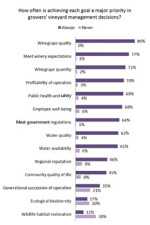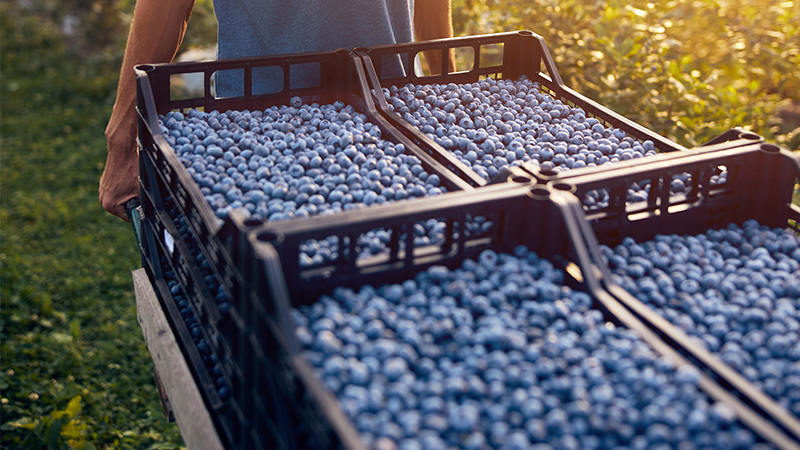Networking Helps Winegrape Growers

In analyzing the 2011 Lodi Winegrape Grower Survey — the results of which were just recently released — the authors found many of the growers in the north-central California appellation have formed a network, are sharing knowledge, and know that being a part of the network is potentially beneficial.
“You don’t want to be a grower existing in the margins, you want to be somewhere near the heart of the network,” says one of the authors, Matthew Hoffman, a Ph.D. candidate at the University of California (UC)-Davis. “Participating in local outreach and education activities — i.e. reading newsletters and attending educational meetings — has a real impact on your vineyard practices, on doing your job better.”
Hoffman is in the Geography Graduate Group at UC-Davis, though he has a bachelor’s degree in viticulture, a master’s degree in rural sociology and sustainable agriculture, and his family grows grapes and vintners wine in the Lodi area. His co-authors on the report are also from UC-Davis: Mark Lubell, a professor in Environmental Science and Policy, and Anthony Hillis, a Ph.D. candidate in the Ecology Graduate Group.
Hoffman said the most important take-home message from the survey for growers was that those who are most successful at adopting innovative viticultural practices are generally the ones most likely to heavily participate in outreach and education activities. “The more you participate in outreach and education, the more you’ll adapt,” he says.
Join The Club
The authors found there is an advice network in Lodi that is potentially a huge help to those who are engaged. The authors believe this network is so vital because growers listed two ways of getting information that were most important. One is personal experience. “Am I keeping records? Am I looking at other people’s vineyards? Am I learning from my mistakes?”
The second is personal relationships. “Am I going out of my way to ask advice from many other growers and viticulture professionals? Am I getting in touch with a diversity of views that could make my knowledge pool rich? Or am I only talking shop with my old high school buddies? Chances are pretty good that my buddies know the same stuff I do, and this means that I won’t be learning anything new,” says Hoffman.
Besides their buddies, growers should be making a point to diversify their advice networks by talking shop with new people, especially what Hoffman refers to as “outreach professionals.” Outreach professionals are people whose job it is to give advice to growers, such as UC Cooperative Extension farm advisers or pest control advisers. The authors found that the people who are at the heart of the network, or those most connected to others, are people who are both growers and outreach professionals.
“These people can have both expert and practical experience, and are well positioned to spread their knowledge,” says Hoffman. “These people are key actors in the agricultural knowledge network.”
The Lodi Rules
The Lodi Winegrape Commission was the first in the state to develop a workbook for growers to implement sustainability, the “Lodi Rules for Sustainable Winegrowing” certification program. The majority of growers support sustainability programs, but not surprisingly find it to be more successful at realizing environmental objectives rather than economic objectives. “There is also a considerable amount of uncertainty around whether the program has achieved various objectives,” the authors state.
Perhaps because of that, support for the programs is a “touchy subject,” says Hoffman. “There are those who oppose the sustainability programs on the suspicion that codifying sustainability practices is a slippery slope to increased regulation and mandated adoption,” he says. “But that’s a fear that hasn’t been borne out.”
The chief complaints about the Sustainable Winegrape Program were the increased amount of record keeping and the increased time to manage the vineyards. The chief benefits were the improved consumer perception of the region and improved winegrape quality, a factor that is uppermost in most growers’ minds.
As far as tangible benefits, a few wineries are offering a small premium of $50 per ton for grapes grown certified sustainable, says Hoffman. But in conducting the survey he now believes there’s a holistic benefit that he hadn’t considered in the past. “Some growers said they participate because it makes them better growers,” he says, “because participating in the certification program helps them keep a magnifying glass on their operation.”
For more information on this survey, eMail Hoffman at [email protected].
About The Survey
The 2011 Lodi Winegrape Grower Survey is actually part of a larger study of grower and vintner adoption of innovative practices, the effectiveness of local outreach and educational programs at achieving various goals, and the role social networks play. The study only includes Lodi, Napa Valley, and the Central Coast regions, because they have long had sustainability programs. Growers in the rest of the state, such as in the San Joaquin Valley, where by far the bulk of California’s winegrapes are grown, have only recently adopted a statewide program.
The authors worked with a 25-person advisory council made up of growers, winery managers, industry experts, and association leaders from around the state to design the surveys. There are a total of three surveys, with the Lodi one the first. The Napa and Central Coast versions, as well as the winery survey, will be delivered this year. Funding for the study comes from the National Science Foundation and the UC Sustainable Agriculture Research and Education Program.









